人教版七年级下册英语复习资料Unit2
- 格式:doc
- 大小:29.00 KB
- 文档页数:4
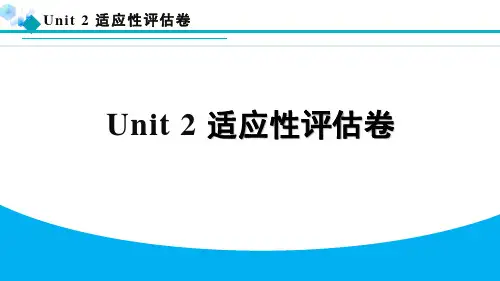
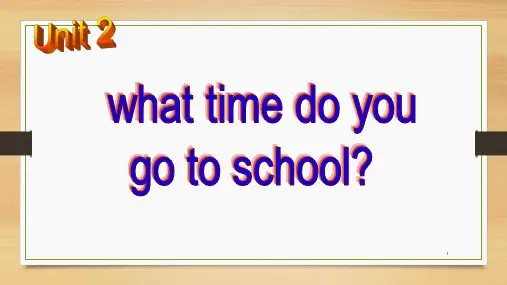
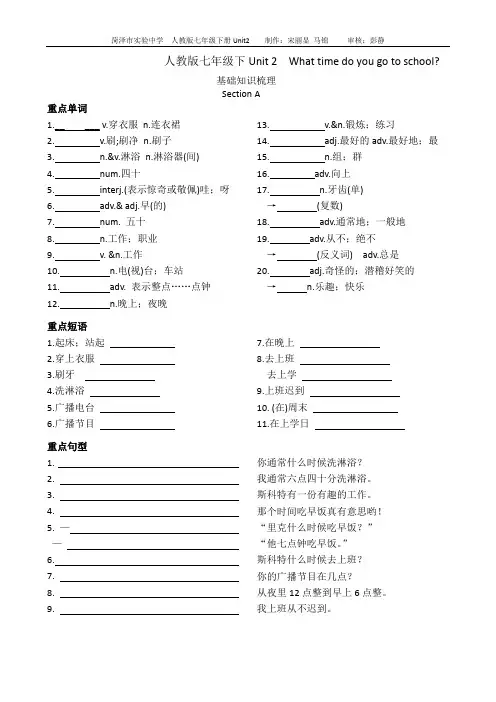
人教版七年级下Unit 2 What time do you go to school?基础知识梳理Section A重点单词1.__ ___ v.穿衣服n.连衣裙2. v.刷;刷净n.刷子3. n.&v.淋浴n.淋浴器(间)4. num.四十5. interj.(表示惊奇或敬佩)哇;呀6. adv.& adj.早(的)7. num. 五十8. n.工作;职业9. v. &n.工作10. n.电(视)台;车站11. adv. 表示整点……点钟12. n.晚上;夜晚13. v.&n.锻炼;练习14. adj.最好的adv.最好地;最15. n.组;群16. adv.向上17. n.牙齿(单)→(复数)18. adv.通常地;一般地19. adv.从不;绝不→(反义词) adv.总是20. adj.奇怪的;潜稽好笑的→n.乐趣;快乐重点短语1.起床;站起2.穿上衣服3.刷牙4.洗淋浴5.广播电台6.广播节目7.在晚上8.去上班去上学9.上班迟到10. (在)周末11.在上学日重点句型1.2.3.4.5. ——6.7.8.9. 你通常什么时候洗淋浴?我通常六点四十分洗淋浴。
斯科特有一份有趣的工作。
那个时间吃早饭真有意思哟!“里克什么时候吃早饭?”“他七点钟吃早饭。
”斯科特什么时候去上班?你的广播节目在几点?从夜里12点整到早上6点整。
我上班从不迟到。
Section B重点单词1. 一半;半数pron,n._________2. 一刻钟;四分之一n._________ 3.跑;奔v._________4.打扫;弄干净v.干净的adj._________ 5.或者conj.也adv._________6.大量;许多pron._________7.品尝v.味道;滋味n._________ 8.晚于prep.过去的adj._________ 9.家庭作业n._________10.行走;步行n.&v._________ 11.很快地adv._________12.生活;生命n._________13.有时adv._________★写出下列单词变形_________1.half-(复数)_________2.quickly(副词)-(形容词)_______ 3.life-(复数)_________4.one-(序数词)_________5. quarter-_(复数)_________ 6.healthy-______(反义词)-(名词)_______7.run-(现在分词)________te-(反义词)_________重点短语★根据汉语提示默写出下列短语1.回家__________________________ 2.做作业__________________________ 3.吃晚饭__________________________ 4.上床睡觉_________________________ 5.做运动_________________________ 6.一个健康的生活__________________ 7.散步;走一走____________________ 8.从学校回到家____________________ 9.去鲍勃家____________________ 10.打扫某人的房间__________________ 11.半个小时____________________12.到家____________________13.大量;许多____________________ 14.对...有好处____________________ 15.尝起来味道好____________________ 16.在下午三点一刻__________________ 17.要么...要么...;或者...或者...____________________18.在晚上差一刻七点_________________ 19.在早晨六点半__________________重点句子★根据汉语提示默写出下列句子1.在晚上,我要么看电视要么玩电脑游戏。

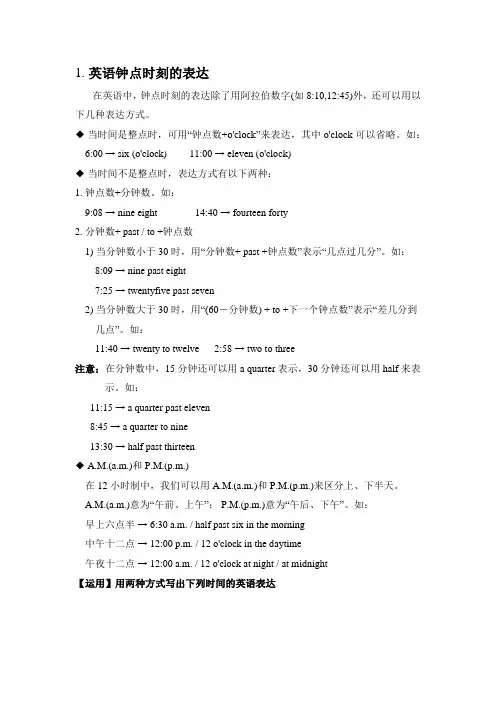
1.英语钟点时刻的表达在英语中,钟点时刻的表达除了用阿拉伯数字(如8:10,12:45)外,还可以用以下几种表达方式。
◆当时间是整点时,可用“钟点数+o'clock”来表达,其中o'clock可以省略。
如:6:00 → six (o'clock) 11:00 → eleven (o'clock)◆当时间不是整点时,表达方式有以下两种:1. 钟点数+分钟数。
如:9:08 → nine eight 14:40 → fourteen forty2. 分钟数+ past / to +钟点数1) 当分钟数小于30时,用“分钟数+ past +钟点数”表示“几点过几分”。
如:8:09 → nine past eight7:25 → twentyfive past seven2) 当分钟数大于30时,用“(60-分钟数) + to +下一个钟点数”表示“差几分到几点”。
如:11:40 → twenty to twelve 2:58 → two to three注意:在分钟数中,15分钟还可以用a quarter表示,30分钟还可以用half来表示。
如:11:15 → a quarter past eleven8:45 → a quarter to nine13:30 → half past thirteen◆ A.M.(a.m.)和P.M.(p.m.)在12小时制中,我们可以用A.M.(a.m.)和P.M.(p.m.)来区分上、下半天。
A.M.(a.m.)意为“午前、上午”; P.M.(p.m.)意为“午后、下午”。
如:早上六点半→ 6:30 a.m. / half past six in the morning中午十二点→ 12:00 p.m. / 12 o'clock in the daytime午夜十二点→ 12:00 a.m. / 12 o'clock at night / at midnight【运用】用两种方式写出下列时间的英语表达1. 2. 3.___________________ 或___________________ ___________________或______________________________________或___________________参考答案1. four thirty; half past four2. eleven five; five past eleven3. nine fifteen; a quarter past nine2. what time & when 引导的特殊疑问句what time和when均可对时间状语进行提问,用来询问什么时间。
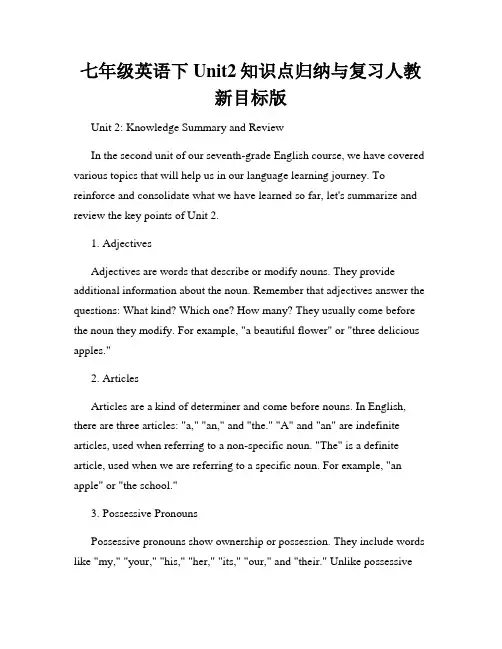
七年级英语下Unit2知识点归纳与复习人教新目标版Unit 2: Knowledge Summary and ReviewIn the second unit of our seventh-grade English course, we have covered various topics that will help us in our language learning journey. To reinforce and consolidate what we have learned so far, let's summarize and review the key points of Unit 2.1. AdjectivesAdjectives are words that describe or modify nouns. They provide additional information about the noun. Remember that adjectives answer the questions: What kind? Which one? How many? They usually come before the noun they modify. For example, "a beautiful flower" or "three delicious apples."2. ArticlesArticles are a kind of determiner and come before nouns. In English, there are three articles: "a," "an," and "the." "A" and "an" are indefinite articles, used when referring to a non-specific noun. "The" is a definite article, used when we are referring to a specific noun. For example, "an apple" or "the school."3. Possessive PronounsPossessive pronouns show ownership or possession. They include words like "my," "your," "his," "her," "its," "our," and "their." Unlike possessiveadjectives, possessive pronouns do not require a noun after them. For example, "Is this pen yours?" or "The book is mine."4. Past Tense of Regular VerbsRegular verbs follow a specific pattern when conjugated in the past tense. We add "ed" to the base form of the verb. For example, "walked," "talked," or "played." However, there are some exceptions and irregular verbs that do not follow this pattern, like "go-went" or "come-came."5. Simple Present TenseThe simple present tense is used to talk about general truths, habits, routines, and scheduled events. It is formed by using the base form of the verb, except for the third-person singular where we add "s" or "es" to the verb. For example, "He plays tennis every Sunday" or "She never eats meat."6. Prepositions of TimePrepositions of time are used to show when an action or event takes place. Some common prepositions of time are "in," "on," and "at." "In" is used for longer periods of time, like months, years, or seasons. "On" is used for specific days or dates, and "at" is used for a specific time. For example, "I will visit my grandmother in July," "We have a math test on Monday," or "The movie starts at 7 p.m."7. Wh-QuestionsWh-questions are questions that begin with "wh-" words, such as "what," "where," "when," "who," "why," and "how." These questions are used togather information. For example, "Where is the library?" or "How do you get to school?"8. Comparative and Superlative AdjectivesComparative adjectives are used to compare two things, where superlative adjectives are used to compare three or more things. To form comparative adjectives, we add "-er" to short adjectives or use "more" before long adjectives. To form superlative adjectives, we add "-est" to short adjectives or use "the most" before long adjectives. For example, "She is taller than her sister" or "This is the most beautiful song I've ever heard."9. Present Continuous TenseThe present continuous tense is used to describe actions that are happening right now or around the present moment. It is formed by using the verb "to be" in the present tense and adding the present participle "-ing" to the base form of the verb. For example, "They are playing soccer" or "We are studying for the exam."Throughout Unit 2, we have explored these essential grammar points in English. By understanding and practicing these concepts, we can enhance our language skills and improve our overall proficiency. Remember to review regularly and apply these knowledge points in your everyday English communication. Keep up the good work, and soon you will become fluent English speakers!。
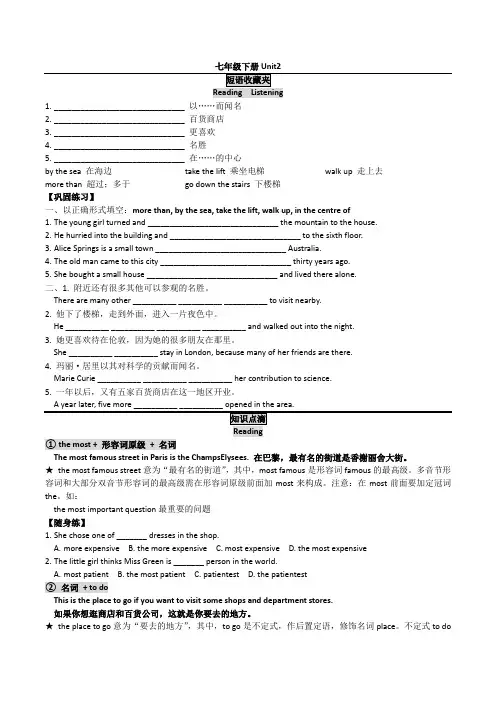
七年级下册Unit21.______________________________ 以……而闻名2.______________________________ 百货商店3.______________________________ 更喜欢4.______________________________ 名胜5.______________________________ 在……的中心by the sea 在海边take the lift 乘坐电梯walk up 走上去more than 超过;多于go down the stairs 下楼梯【巩固练习】一、以正确形式填空:more than, by the sea, take the lift, walk up, in the centre of1.The young girl turned and ______________________________ the mountain to the house.2.He hurried into the building and ______________________________ to the sixth floor.3.Alice Springs is a small town ______________________________ Australia.4.The old man came to this city ______________________________ thirty years ago.5.She bought a small house ______________________________ and lived there alone.二、1. 附近还有很多其他可以参观的名胜。
There are many other __________ __________ __________ to visit nearby.2. 他下了楼梯,走到外面,进入一片夜色中。
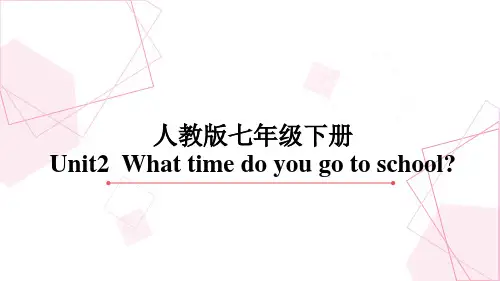
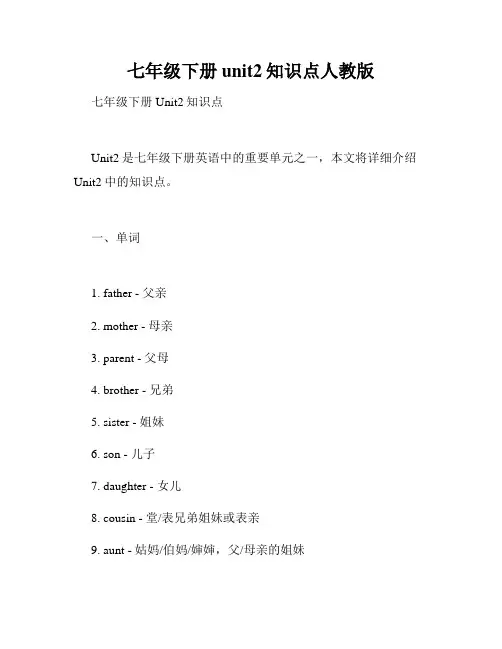
七年级下册unit2知识点人教版七年级下册Unit2知识点Unit2是七年级下册英语中的重要单元之一,本文将详细介绍Unit2中的知识点。
一、单词1. father - 父亲2. mother - 母亲3. parent - 父母4. brother - 兄弟5. sister - 姐妹6. son - 儿子7. daughter - 女儿8. cousin - 堂/表兄弟姐妹或表亲9. aunt - 姑妈/伯妈/婶婶,父/母亲的姐妹10. uncle - 叔叔/舅舅/伯伯,父/母亲的兄弟二、句型1. Whose...is this? - 这是谁的......?2. It's his/hers/my/mine/our/ours/your/yours/their/theirs. - 这是他的/她的/我的/我们的/你的/他们的。
3. Who's he/she? - 他/她是谁?4. He/She is my father/mother/brother/sister/cousin/uncle/aunt. - 他/她是我的父亲/母亲/兄弟/姐妹/表兄弟姐妹/叔叔/姑妈/伯妈/婶婶/舅舅/伯伯。
三、语法1. 物主代词物主代词分为形容词性物主代词和名词性物主代词。
形容词性物主代词:my, your, his, her, its, our, their名词性物主代词:mine, yours, his, hers, its, ours, theirs 例如:This is my book. → This book is mine.2. 一般现在时一般现在时表示现在的状态、行为或习惯。
主语 + 动词原形 + 其他。
例如:My mother works in a hospital.3. 疑问词疑问词有一般疑问句和特殊疑问句。
一般疑问句:将be动词或者助动词放在句首。
例如:Are you a teacher?特殊疑问句:以疑问词为开头,后跟一般疑问句的陈述部分。
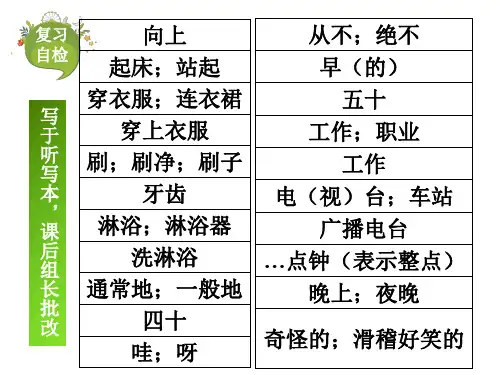

七年级下册英语人教版unit2知识点七年级下册英语人教版Unit 2 知识点本文将介绍七年级下册英语人教版Unit 2的知识点,包括单词、词组、语法和重点句型。
一、单词1. plant:植物2. tree:树3. flower:花4. grass:草5. insect:昆虫6. bird:鸟7. mammal:哺乳动物8. reptile:爬行动物9. amphibian:两栖动物10. zoo:动物园11. aquarium:水族馆12. national park:国家公园13. protect:保护14. environment:环境15. pollution:污染二、词组1. protect the environment:保护环境2. take care of:照顾3. both...and...:既...又...4. not only...but also...:不仅...而且...5. be afraid of:害怕6. in danger:处于危险之中7. look like:看起来像8. kind of:有点儿9. any more:再也不三、语法1. 一般现在时一般现在时表示经常性的动作或状态。
例如:I get up at six o'clock every morning.(我每天早上六点起床。
)He goes to school by bike.(他骑自行车去上学。
)2. 一般过去时一般过去时表示过去某个时间发生的动作或状态。
例如:I watched TV last night.(昨晚我看了电视。
)She played basketball with her friends yesterday afternoon.(昨天下午她和朋友们一起打了篮球。
)3. 一般将来时一般将来时表示将来的动作或状态。
例如:I will go to the zoo next Sunday. (下个星期日我将去动物园。
Unit 2 What time do you usually go to school?一、词汇拓展1.brush(单三)brushes2. tooth(复数)teeth3. always (反义词)never4.early(反义词)late5. work(同义词)job6. night(反义词)day7. half(复数)halves8. run(现在分词)running9. life(复数)lives二、重点短语1.get up起床2. get dressed穿上衣服3. have/take a shower 淋浴4.brush teeth涮牙5. go to school/work 去学校/上班6. at night 在晚上7. on weekends 在周末8. on school days 在上学期间9.have(eat) breakfast /dinner吃早餐/晚餐10.do (one's) homework 做作业11. take a walk 散步12. in the morning/ afternoon/ evening 在上午/下午/晚上13. go to bed上床睡觉14. go home 回家15. eat quickly 吃得快16. play sports 做运动17. for half an hour 长达半小时18. get home 到家19. get to school 到校20. eat a good breakfast吃一顿好的早餐21. after lunch /dinner 午餐/晚餐后22. taste good 尝起来好吃23. have a very healthy life 有健康的生活24. from Monday to Friday从周一到周五25. radio station广播电台三用法集萃1.What time 几点,何时2. either…or 要么……要么,或者…..或者(做主语时,谓语就近原则)3.need to do sth 需要做某事4. be good for 对……有益/有好处5. eat…for breakfast/ lunch/dinner 早/午晚餐吃……6. lots of+可数名词复数/不可数名词许多的,大量的= a lot of…7. half past +钟点数几点半8. be late for…做……迟到9. from…to…从……到……10. have time to do sth / have time for sth. 有时间做……11. That's a funny time for…那是做……有意思的时间。
人教版英语七年级下册unit2笔记全文共3篇示例,供读者参考篇1Unit 2 Pen PalsPart 1: Key Vocabulary1. Pen pals - friends who communicate through letters or emails2. Foreign - from another country3. Geography - the study of the Earth's physical features and atmosphere4. Capital - the most important city or town of a country5. Australia - a country in the southern hemisphere6. Argentina - a country in South America7. Ireland - a country in Europe8. Nationality - the status of belonging to a particular country9. Flag - a piece of colored cloth with a symbol or design representing a countryPart 2: Grammar1. Present Simple Tense- Used for habits or things that always happene.g. She reads books every day.- Used for general truths or factse.g. Water boils at 100 degrees Celsius.2. Question Words- Who, what, where, when, why, and howe.g. Who is your pen pal?- Used to ask for informatione.g. What is the capital of Australia?Part 3: Reading and WritingPen Pal Profiles- Name: Anna- Age: 13- Nationality: Australian- Hobbies: surfing, painting, and playing the guitar- Favorite foods: Vegemite on toast, meat pies- Dream: to become a successful artistLetter WritingDear Pen Pal,I hope this letter finds you well. My name is Anna, and I am13 years old from Australia. I love surfing, painting, and playing the guitar. My favorite foods are Vegemite on toast and meat pies. I dream of becoming a successful artist one day.I would love to learn more about your country and its culture. Can you tell me about the capital of your country and some interesting facts about it? I'm looking forward to hearing from you soon.Best wishes,AnnaPart 4: Speaking- Practice asking and answering questions about pen pals, countries, and nationalities- Role-play scenarios where students introduce themselves and their hobbies to each otherUnit 2 Pen Pals provides students with the opportunity to learn about different cultures, improve their writing skills, and practice speaking in English. By communicating with pen pals from around the world, students can broaden their horizons and make new friends.篇2Unit 2 My DayLesson 1 Getting up1. get up: 起床2. have breakfast: 吃早餐3. brush teeth: 刷牙4. wash face: 洗脸5. go to school: 上学6. take a shower: 洗澡7. do morning exercises: 做早操Lesson 2 Classes start1. classes: 课程2. start: 开始3. finish: 结束4. go to bed: 上床睡觉5. listen and repeat: 听并重复6. learn: 学习7. do homework: 做家庭作业8. watch TV: 看电视Lesson 3 Am I late1. late: 迟到2. early: 早3. teacher: 老师4. study: 学习5. have lunch: 吃午饭6. play with: 和......玩7. be careful: 小心8. go home: 回家Lesson 4 My day1. woke up: 醒来2. went to school: 去学校3. had lunch: 吃午饭4. played football: 踢足球5. did my homework: 做我的作业6. watched TV: 看电视7. went to bed: 上床睡觉8. tired: 累9. hungry: 饿Lesson 5 It's 8:001. It's: 是2. what time: 几点3. on time: 准时4. festival: 节日5. celebrate: 庆祝6. put up: 放起7. Mid-Autumn Festival: 中秋节8. Dragon Boat Festival: 端午节Lesson 6 It's time to go home1. time: 时间2. goes home: 回家3. leave: 离开4. have dinner: 吃晚饭5. read: 读6. storybook: 故事书7. good night: 晚安8. sleepy: 困Lesson 7 My Clock1. clock: 时钟2. hour: 小时3. minute: 分钟4. second: 秒5. o'clock: 点钟6. half past: 二十五点7. quarter past: 差一刻点钟8. quarter to: 差三刻点钟Unit 2 Key Sentences1. What's the time2. It's eight o'clock3. It's half past seven4. It's twenty past nine5. It's a quarter to four6. Am I late7. No, you're not8. Yes, you are9. Can you tell me the time, please10. I woke up at seven11. I went to school at eight12. I had lunch at twelve13. I did my homework at four14. I watched TV at six15. I went to bed at nineThis unit introduces how to talk about daily routine and tell the time in English. By learning these key words and sentences, students will be able to describe their day and understand different time expressions.篇3Unit 2 My DayIn Unit 2 of the seventh grade English textbook, students are introduced to the vocabulary and phrases related to daily routines and activities. This unit serves as a foundation for students to talk about their daily schedules and habits in English.Vocabulary: The unit covers essential vocabulary related to daily routines, such as "get up", "have breakfast", "go to school", "do homework", "watch TV", "go to bed", and more. Students are expected to learn these words and phrases in order to describe their daily activities.Grammar: In Unit 2, students also learn basic grammar structures to talk about their daily routines, such as the present simple tense. They will be able to form sentences like "I get up at7 o'clock every morning" or "She goes to bed early on weekdays".Listening and Speaking: Students will engage in various listening activities to practice understanding spoken English about daily routines. They will also have the opportunity to discuss their own daily schedules with their classmates.Reading and Writing: In this unit, students read short texts about the daily routines of people from different countries. They will also practice writing about their own daily activities, using the vocabulary and grammar structures they have learned.Exercises and Activities: Unit 2 includes a variety of exercises and activities to help students consolidate their knowledge of daily routines. These may include gap-fill exercises, matching activities, role plays, and more.Cultural Information: Throughout the unit, students will also learn about the daily routines and habits of people from different cultures around the world. This provides students with a broader understanding of how daily life can vary among different countries and societies.Overall, Unit 2 of the seventh grade English textbook is designed to help students develop their English language skillsin the context of daily routines. By the end of the unit, students should be able to describe their own daily activities, as well as understand and talk about the daily routines of others.。
Unit 2 What time do you go to school?知识点总结◆短语归纳1. what time几点2.go to school去上学.3. get up起床4. take a shower洗淋浴5. brush teeth刷牙6.get to到达7.do homework做家庭作业8. go to work去上班9. go home回家10. eat breakfast吃早饭11. get dressed穿上衣服12. get home到家13. either...or...要么..要么... 14. go to bed上床睡觉15. take a walk散步16. lots of=a lot of许多,大量17. radio station广播电台18.吃得快eat quickly 19. at night在晚上20. be late forarrive late for ..迟到21.从...到... fo..o.22.at the weekend/at weekends在周末23. 尝起来不错taste good 24.过着健康的生活live a healthy life◆典句必背1. What time do you usually get up? I usually get up at six thirty.2. That's a funny time for breakfast.3. When do students usually eat dinner? They usually eat dinner at a quarter to seven in the evening.4. In the evening, I either watch TV or play puter games.5. At twelve, she eats lots of fruit and vegetables for lunch.6. She knows it's not good for her, but it tastes good.◆考点1、时间介词:on/in/at 辨析(1) at+钟点,固定搭配at noon在中午,at night在晚上(2) in+月、季节、年、世纪,或固定搭配in the morning /afternoon/evening在早上下午/晚上(3)on+具体某一天/星期几或具体某一天的早中晚以及带有修饰词的早中晚on April 1st on Sunday on a cold winter morming2、时间读法:顺读法:小时+ 分钟3:40 three forty逆读法:分钟≤30用past five past eight (8:05) half past eight ( 8:30)分钟>30用to. a quarter to ten (9:45)整点用.o clock 7 o'clock (7:00)几点半: half past+时刻15分钟: a quarter▲问时间用what time或者when3、频度副词:由于be,助,情之后;实义动词之前。
人教版英语七年级下册第二单元Unit 2 What time do you go to school?复习用资料人教版英语七年级下册第二单元主要话题是“谈论日常活动”,为此,整个内容以“What time do you go to school?”的问句展开,紧接着通过答语告诉我们如何表达时间,后来又通过对话、听力、阅读等方式进一步巩固所学知识,接下来,我们就一起来总结一下。
1、关于询问时间。
英语里面,如果直接询问对方时间,可以用句型:What time is it? 回答:It’s…例如:A: What time is it? 几点了?B: It’s seven o’clock. 七点钟2、关于询问做某事的时间。
What time \ When do \ does sb. do sth.?例如:What time do you get dressed? 你几点穿好衣服?例如:What time do they usually go to work? 他们通常几点去上班?又如:When does Tom have lunch?汤姆什么时候吃午饭?3、关于时间的正确表达方式。
英语里时间的表达有两种方式,一种是顺读法,即按照时间顺序,先读小时,再读分钟。
另一种是逆读法,先读分钟,再读小时。
接下来,我们就来一一介绍。
顺读法:(1)、整点,用数字+ o’clock;例如:12:00 twelve o’clock 3:00 three o’clock (2)、非整点,先读小时对应的数字,再读分钟对应的数字;例如:4:16 four sixteen 7:47 seven fortyseven。
逆读法:(1)、当分钟数小于30时,用“分钟对应的数字+ past + 小时对应的数字”,例如:8:12 twelve past eight 9:28 twentyeight past nine 10:08 eight past ten特殊情况:当分钟数等于15时,15可以用英语单词“a quarter来表示”,例如:6:15 a quarter past six;又如:9:30half past nine。
Unit2
1brush(v、n)
巧记:b+rush(匆忙)—brush
短语:牙刷toothbrush 梳子hairbrush 画笔paintbrush
刷鞋brush one’s shoes /teeth
晚饭后你最好刷刷牙__________________________________
2 tooth(n)
巧记:too(也)+th—tooth
类似tooth这样复数形式发生不规则变化的词还有很多:
Foot—feet mouse—mice man—men
Child—children policeman—_________ ox—________
goose—_________
3shower(n/v)
巧记:show(展览,演出)+er=shower
我需要洗个淋浴__________________________________
短语:一场阵雨__________________
4 never: n+ever(曾经)=never
我从不迟到_______________________________
5 early: (adv/adj)
巧记:ear+ly=early
她一大清早就出去了_______________________
Early morning/afternoon/evening清晨、午后、黄昏
Early spring/summer早春、初夏
6 job(n)工作、职业
短语:失业_______________兼职工作__________________
辨析:job指“雇用”工作是可数名词
Work指一般的工作,是不可数名词
7 station:(n)
火车站_____________公共汽车站_________________
电视台________________
8 exercise (v/n)
经常锻炼身体对身体十分重要___________________________
大多数人需要锻炼_____________________________________
注意:exercise意为“锻炼、运动”时是不可数名词,意为“练习”的时候为可数名词Eg: do/take exercise锻炼身体、做运动
Grammar exercise语法练习
9 best (adj)
Good/well—more—best
她是我最好的朋友__________________________________________
10 past
Pass经过—past
冬天过去了,春天终于要来临了_____________________________
11quarter(n)
我一刻钟之后与你会面____________________________________
12 clean (n/v)
Clear(清楚)—clean
反义:dirty
放学后请打扫教室________________________________________
你的手干净吗____________________________________________
13walk (n/v)
他喜欢散步_________________________________________
短语:散步—have/take a walk
去散步—go for a walk
突然离席,退席—walk out
14 taste(v)
我不喜欢这个汤的味道____________________
Tasteful:有品味的,有鉴赏力的
15 clean my room 打扫房间
扩展:表示清洁的单词还有:
1.wash用肥皂和水来洗
2.sweep用扫帚来扫
3.wipe 用湿布来擦
4.mop用水和拖把拖
5.scrub用力擦洗
6.dust 用布等除尘
7.brush用刷子刷去污垢7.Polish用布擦亮
16 either or是并列连词短语。
表示:要么……要么。
在晚上,我要么看电视,要么玩电脑游戏。
__________________________ 在使用时注意一下几点:
1:连接两个成分做主语时,谓语动词与最近的主语保持一致。
Either he or you___right.
Either you or he ____right\
2:除了两个词或短语外,有时也连接两个句子。
Either you leave this house or I’ll call the police
3:否定为neither……nor 也可以是not either or
He didn’t either write or phone =He neither wrote nor phoned
( ) 1 -Have you got some water to drink?
-Here you are. There___ still some in the bottle.
A. are
B. were
C. is
D. was
( ) 2 _____ there many American friends in the school last Friday?
A. Is
B. Was
C. Are
D. Were
( ) 3 There ____ a great many accidents last year.
A. were
B. are
C. is
D. was
( ) 4 -How many children ____ in the picture?
-Three.
A. has there
B. is there
C. have there
D. are there
阅读理解:
Clay is 13 years old, and he lives in Miami, the United States. On the morning of Feb.23, when Clay is waiting for school bus, a man kidnaps(绑架)him.
The man takes him to a tree. He puts a stock in Clay’s mouth. Then he asks for money from Clay’s family.
Clay is very scared(害怕). But he remembers there is a safety pin(安全别针)in his pocket. He takes out the pin and cuts through the rope(绳子). Finally he gets free. Clay calls his mother with a farmer’s cell phone. Soon the police comes and Clay is safe.
The police thinks highly of(高度评价)Clay. “This man kidnaps the wrong boy,” Charly Wells,
a policeman says. “This boy notices things. And he’s very brave(勇敢).”
1. The man kidnaps Clay ___.
A. on Clay’s way home
B. on Clay’s way to school
C. when Clay is shopping
D. in a park
2. After taking Clay to a tree, the man ___.
A. kills(杀死)the boy
B. hurts the boy
C. asks for money from his family
D. calls the police
3. Clay uses___ to help him run away.
A. a rope
B. a safety pin
C. a gun
D. a knife
4. We can tell from the story that Clay is ___.
A. brave
B. smart
C. both A and B
D. hard-working
5. Why does the police say “This man kidnaps the wrong boy” Because Clay is _____
A. a foreign boy
B. brave
C. too young
D. a policeman’s son
Fun time!!!
Cats and dogs
小朋友,你知道cats and dogs是什么意思吗?先听一个故事吧:北欧神话传说中,神奇的猫能使天气变化;狗呢,则是风的使者。
猫(cat)和狗(dog)形同水火,它们一见面,便是狂风暴雨,好像在打架。
所以“倾盆大雨”就被描述成rain cats and dogs。
“商标”英语
小朋友们,在日常生活中,我们可能会接触到许多英语商标。
知道它们是什么意思吗?一起来学习一下吧!
乐百氏Robust 有活力的,健康的
雪碧Sprite 小精灵
美登高Meadow Gold牧场的盒子
纳爱斯Nice 美好的
舒服佳Safeguard 安全卫士
乐凯Lucky 幸运的。